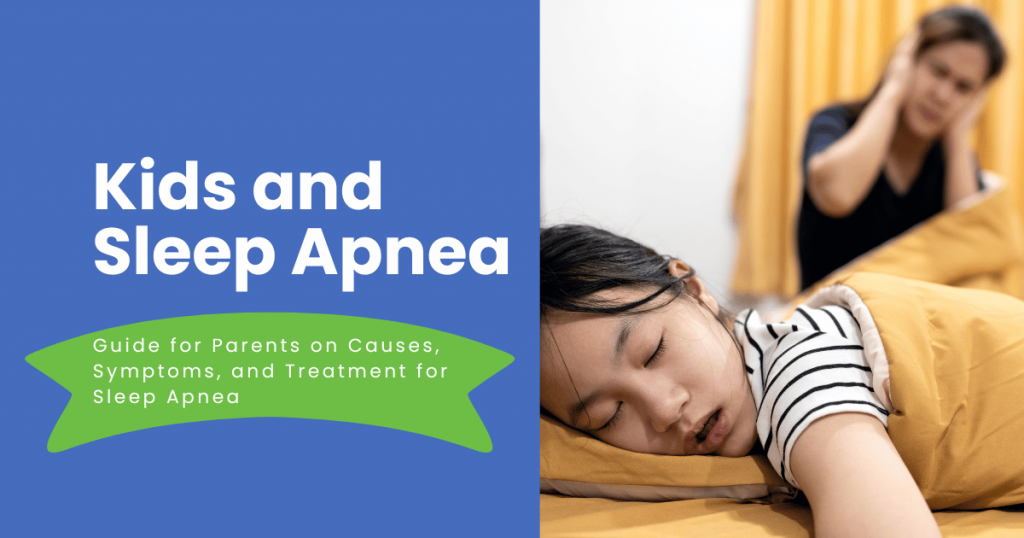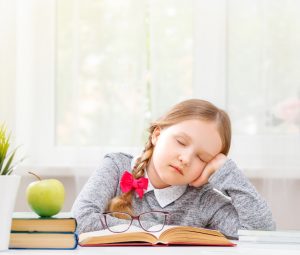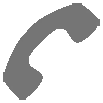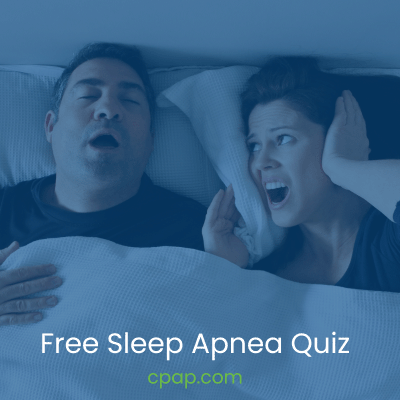
Sleep apnea in children is characterized by changes in your child’s breathing patterns while they are asleep. These can include episodes in which breathing is simply shallow and slow, or respirations may pause altogether.
Pediatric sleep apnea can be very concerning if it goes on unaddressed. Because of this, it is important to recognize the signs and symptoms of sleep-disordered breathing. That’s why today we will be discussing this condition in depth so that you know what to look for when deciding whether or not your child needs to be seen by their healthcare provider.
In this article, we will talk about what sleep apnea actually is, as well as explore the different types and their causes. We will explain the signs and symptoms that you should be watching for, plus tell you what to expect when seeking a diagnosis. Additionally, we will go over the most common treatment options for childhood sleep apnea. And lastly, we will talk about when you should reach out to your child’s doctor and why.
What is Sleep Apnea?
Sleep apnea is a disorder in which breathing becomes difficult during sleep either due to blockages in the airway or failure of the respiratory muscles. This causes oxygen levels to drop at certain points during sleep. These episodes are referred to as periods of:
- Hypopnea: breathing becomes slow and shallow
- Apnea: respiration pauses altogether for a short period of time
When breathing becomes significantly impacted, the brain responds by sending a signal to rouse you from sleep so that you can take a breath of air. These episodes can cause people with sleep apnea to wake up feeling as though they are choking and gasping during sleep. And if they become a regular occurrence they can seriously impact your sleep quality, resulting in excessive daytime fatigue. Sleep apnea can be a serious condition that may require medical treatment. So if you have concerns that your child could have sleep apnea, it’s important to speak with their healthcare provider about your concerns.
Types of Sleep Apnea:
There are three main types of sleep apnea:
- Obstructive Sleep Apnea: As the name suggests, OSA is characterized by the obstruction of the airway. These blockages occur when the muscles of the tongue, soft palate, and throat collapse into the upper airway as a result of the additional muscle relaxation that occurs during sleep. These obstructive events are more likely when the diameter of the throat and/or airway is reduced in size due to natural anatomical differences or certain underlying conditions.
- Central Sleep Apnea: CSA occurs as a result of the brain’s inability to sense changes in the amount of carbon dioxide in the blood and/or communicate with the respiratory muscles that it is time to take a new breath. These issues can arise either due to a problem with the brain, the nerves through which those signals are sent, or the muscles themselves. Regardless of the cause, the result is the same— the muscles are unable to contract, meaning the lungs are unable to bring in air.
- Complex Sleep Apnea: This form of sleep apnea arises when a person being treated for OSA develops CSA in response to CPAP therapy.
Causes of Sleep Apnea in Children
The most common causes of sleep apnea in toddlers and kids differ slightly from the issues that trigger adult cases. While obesity can result in a case of OSA and/or CSA in both adults and children
Obstructive Sleep Apnea in Kids
Here are some reasons that Obstructive Sleep Apnea may arise in a child:
- Obesity: Obesity tends to cause the muscles of the head and neck to weaken, this can leave those muscles more prone to collapsing during sleep, which leads to sleep apnea.
- Enlarged Tonsils and Adenoids: When the adenoids or tonsils become enlarged, they may block the throat and upper airway.
- Abnormal Anatomy: Structural problems in the mouth, nose, throat, or airway can leave people predisposed to airway obstruction. These can occur either due to injury, illness, or genetics.
- Neuromuscular Conditions: Neuromuscular conditions, such as Cerebral Palsy, can impact the likelihood of the muscles of the mouth, throat, or upper airway collapsing during sleep.
- Genetic Conditions: Genetic conditions can impact airway anatomy or respiratory muscle function. One example is Juvenile Huntington’s Disease.
- Asthma: Studies have shown that children with asthma are at an increased risk for developing OSA.
- Allergies: Allergies cause inflammation and swelling in the airway, which increases the risks of the airway becoming blocked.
- Acid Reflux: Gastroesophageal Reflux Disease (GERD), which is caused by chronic acid reflux, can lead to throat and neck airway irritation, which makes airway obstruction more likely.
- Medications: Taking certain medications, such as opioids or sedatives, can affect breathing.
- Nose and Sinus Problems: When the nose or sinuses are congested or inflamed, we tend to breathe through our mouths more often during sleep. Doing so can increase the likelihood of the muscles in the throat or airway collapsing, leading to airway obstruction. This problem can also occur as a result of a deviated septum.
- Family History: Many of the factors that contribute to OSA can be genetic. Therefore, a family history of OSA indicates an increased risk of developing this condition.
- Exposure to Smoking: Smoking and being around cigarette smoke can lead to inflammation of the throat and airways, which has been linked to child sleep apnea.
Central Sleep Apnea in Kids
The following are some of the causes of CSA in children:
- Neurological Conditions: These types of conditions can increase the likelihood of issues arising between the respiratory muscles, nerves, and brain.
- Brain Conditions: Some types of brain conditions have been linked to Central Sleep Apnea, including tumors.
- Cardiovascular Conditions: Cardiovascular conditions can lead to changes in the amount of carbon dioxide in the blood, which can lead to the development of Central Sleep Apnea. One of the more common heart conditions which can lead to sleep apnea in kids is Congenital Heart Disease.
- Prematurity: Babies who are born early are at a higher risk of having central sleep apnea due to immature brain development that can affect the part of the brain that manages the respiratory process during sleep.
- Medications: Certain medications can affect the respiratory system, which can increase the risk of developing central sleep apnea. These include opioids and sedatives.
- Obesity: Obesity has been linked to central sleep apnea. Although the connection is not entirely understood, it is believed that obesity can impact the communication between the respiratory muscles and the brain.
- Genetics: Like Obstructive Sleep Apnea, there may be a genetic component to central sleep apnea. Research shows that it can run in families.
- High Altitude: Being at a high altitude changes the oxygen and carbon dioxide levels in the blood, which can trigger CSA.
Symptoms of Sleep Apnea in Kids
Regardless of the type of sleep apnea, the condition causes repeated arousal from deep sleep. This tends to lead to excessive sleepiness, which may cause some significant changes in your child’s mood and behavior during the day. Here are some of the symptoms of pediatric sleep apnea:
- Snoring (more common with OSA than CSA)
- Pauses in breathing with choking, snorting, or gasping for air
- Unusually heavy mouth breathing during sleep
- Restless sleep
- Difficulty waking up in the morning
- Trouble staying awake during the day
- Increased bedwetting
- Behavioral changes
- Mood changes
- Loss of attention or focus
- Changes in performance at school
- Morning headaches
- Sleep waking or talking
Diagnosing Pediatric Sleep Apnea
The consequences of untreated sleep apnea in children can be quite serious. They can range from future health complications to difficulties in school. If you are concerned that your child may have sleep apnea, it is important to speak with their doctor so that they can determine the right course of action.
Preparing for the Appointment
When showing up to your child’s first appointment, it may be helpful to bring documentation of the signs and symptoms you feel your child is exhibiting. This may include a diary of the changes you are seeing, or it could be as simple as taking a recording of your child’s snoring or breathing as they sleep. The doctor will ask questions about their medical history and will likely look to you for insight as to how their health and wellness have changed over time.
Physical Examination
Your child’s provider will likely want to check their blood pressure and blood oxygen levels just to make sure that they are not abnormal during the day as well. The doctor will then perform a physical examination, which will likely include the following areas of the body:
- Chest
- Mouth
- Nose
- Throat
- Neck
Sleep Studies
If the doctor suspects that your child may have some sort of sleep-disordered breathing condition, they will likely order a sleep study. This test allows a specialist to observe how your child’s breathing changes as they sleep. Depending on your and the physician’s preferences, this sleep study may be performed at a specialty clinic or at home.
There are two common types of sleep tests for children:
- Polysomnogram: This type of test is usually done at an overnight sleep clinic. These studies involve sensors attached to the head to measure brain waves, along with other sensors attached to other parts of the body that check breathing patterns, oxygen levels, heart rate, and movements.
- Oximetry: This test allows for the continuous recording of oxygen levels throughout the night. It is more common for people who are doing a home-based test. This test specifically looks for periods in which the oxygen levels drop significantly to indicate periods of apnea or hypopnea.
Results
Once the study has been completed a specialist will check the results and measure the number of times their oxygen levels or breathing patterns were impacted for more than ten seconds each. There are different types of measurements that can be used to determine the presence of sleep apnea. These depend on the type of test performed, plus the type of sleep apnea that is suspected.
- Apnea Hypopnea Index: AHI measures the number of times ventilation is reduced or paused altogether (for more than ten seconds) per hour of sleep. An AHI of five or more indicates Obstructive Sleep Apnea.
- Respiratory Disturbance Index: RDI is a system for measuring breathing changes that are similar to AHI, except it is for at-home studies. An RDI of five or more suggests the presence of OSA.
- Central Apnea Hypopnea Index: CAHI checks for breathing changes that are associated with central sleep apnea. Like the other measurement systems, CAHI also checks for periods of apnea and hypopnea but only counts the episodes that are associated with Central Sleep Apnea. A positive result for central sleep apnea requires five or more events per hour, with more than 50% of them attributed to “central” apnea.
Treating Sleep Apnea in Children
The treatment for sleep apnea can sometimes differ a bit depending on whether the person is a child or an adult. Sleep apnea in babies, toddlers, and older kids tends to be linked to some sort of underlying issue, whereas adult cases are more likely to arise due to lifestyle choices. Your child’s doctor will likely suggest an individualized treatment approach to address their sleep apnea, along with the specific causes of their condition.
Treatments of sleep apnea in pediatrics usually include one or multiple of the following:
- Adenoid and Tonsil Removal: Your child’s doctor may suggest surgically removing the tonsils and adenoids to reduce the risk of them causing obstruction of the airway.
- Strengthening Therapy: Mouth and throat exercises may be helpful in reducing the risk of blockages that are caused by the collapse of muscles along the mouth, throat, and upper airway.
- Oral Appliances: Dental devices such as sleep apnea mouthguards may be useful for reducing the number of apnea and hypopnea episodes due to OSA. Oral Appliance Therapy has been used to position the jaw and tongue so that airway obstruction is less likely to occur. Other options include soft palate lifters, which keep the muscles of the soft palate from collapsing into the upper airway.
- Continuous Positive Airway Pressure (CPAP): CPAP machines are often the first line of treatment for sleep apnea in adults. However, while it is still a popular therapy for children with sleep apnea, it isn’t suggested quite as often in pediatric cases. CPAP machines work by delivering pressurized air through the airway and into the lungs. The flow of air acts almost as a brace to keep the airway open during sleep. Additionally, it has proven to be helpful for children with Central Sleep Apnea, as the airflow helps the body to maintain regular respirations.
- Treating Underlying Conditions: Treatment for underlying conditions is among the most important aspect of managing sleep apnea in children. Treatment plans will differ based on your child’s diagnosis but can include physical, speech, or occupational therapy, medication, medical devices, and more.
- Lifestyle Changes: Because sleep apnea can be attributed to certain living conditions or lifestyle choices, it may be helpful to make dietary changes if your child’s sleep apnea is attributed to obesity. Other suggestions include avoiding cigarette smoke and allergens.
- Side Sleeping: Having your child sleep on their side can reduce the likelihood of airway obstruction during sleep.
Health Risks Associated with Sleep Apnea During Childhood
Untreated sleep apnea can lead to a few issues later on down the road. Sleep apnea has been proven to increase the risk of chronic inflammation and other conditions. Additionally, it can also lead to problems in your child’s life, such as poor grades and trouble maintaining relationships.
When to See a Doctor
If you have any concerns about your child’s health and wellness, it is important to seek the advice of a healthcare professional. This also goes for sleep apnea in children. If you have noticed changes in your child’s behavior or have been informed that they are struggling in school, consider the underlying reasons for these changes. If such issues arise along with snoring and/or signs of excessive sleepiness, we encourage you to schedule an appointment with your child’s doctor.
Conclusion
Noticing changes in your child’s health and wellness can be very concerning, especially when those issues involve their breathing while they are asleep. One potential cause may be a treatable condition called sleep apnea, which arises when your child’s breathing has been slowed or temporarily paused. This can occur due to airway obstruction or problems with the brain’s ability to regulate breathing.
Oftentimes this condition leads to very poor sleep, and you may even start to see changes in your child’s ability to stay awake and function properly throughout the day. While this may sound scary, it is important to remember that there are many treatment options that can reduce the likelihood of your child experiencing any negative effects of this condition. That is why it is important to seek the advice of your child’s healthcare provider if you have any concerns about their risk for sleep apnea.
Think You May Have Sleep Apnea? Take Our FREE Sleep Apnea Quiz!
How Does Sleep Apnea Manifest in Children?
Unfortunately—as you already know—kids don’t come with instruction manuals, and sometimes it’s hard to know when something is “normal kid behavior” vs. something that should be evaluated by a doctor. When in doubt, go to the doctor.
But in the meantime, here are a few symptoms to watch for regarding sleep apnea in children:
At night:
- bed wetting
- coughing or choking while sleeping
- mouth breathing
- night terrors
- sleeping in strange positions
- snoring (Unless the child is suffering from a cold or respiratory illness, snoring should be cause for concern.)

During the day:
- difficulty waking up or getting up in the morning
- fatigue
- tiredness throughout the day
Over the course of a few days or weeks, keep a simple journal of things you notice regarding your child’s sleep. This could prove helpful when you talk to your child’s doctor. If possible, observe your child while he’s sleeping. Does anything seem out-of-the-ordinary? Follow your gut.
Keep in mind, not all symptoms apply to every child who may be struggling with sleep apnea. Infants and toddlers, for example, may not snore. But they may show some of the other signs that they are struggling to get a good night’s rest. And it should be noted that while one of the most recognizable symptoms for sleep apnea in adults is daytime drowsiness, one of the most common symptoms for children is behavioral problems due to fragmented sleep patterns.
If your child has sleep apnea, they’re probably tired and just don’t know how to identify or express it in a healthy way.
What Happens if Sleep Apnea Goes Unaddressed in Children?
If left unaddressed, children can struggle with the following ongoing issues:
- difficulty staying on task or paying attention
- hyperactivity
- learning struggles
- poor performance in school
- poor weight gain
Until recent years, snoring wasn’t viewed as anything to be too concerned about in children. According to the Journal of the American Academy of Pediatrics, children who snore are twice as likely to struggle with learning problems. Meaning, while you may be frustrated with your child’s poor performance in school, your child may be equally frustrated by ongoing exhaustion that actually looks to other people like hyperactivity.
A quick look at the symptoms makes it easy to understand how the disorder can be misdiagnosed in so many children.
But as is the case with most disorders, early diagnosis and accurate treatment are critical. Not only is it important for a child to get diagnosed so that he or she can return to a good night’s sleep, but it is also important for the child’s behavioral and cognitive development. It is no secret that children need good and regular sleep patterns to grow and reach their full potential.
What Is the Long-Term Prognosis?
How does sleep apnea affect a child in the long run? The good news is that children who receive timely and accurate treatment are often able to function in healthy ways, and sleep apnea may not follow them into adulthood. Children who do not receive the treatment they need can face longer-lasting consequences related to their mental and physical health.
Treatment options often include targeting underlying causes, such as allergies, orthodontic issues, or tonsillectomy. For some children, the answer may be a CPAP, which can prove very helpful. As the child grows, so, too, do treatment options.
Thankfully, many parents and healthcare professionals alike are beginning to better recognize the symptoms and the solutions for sleep apnea in children.
For children—as well as their parents—this is a win/win.





